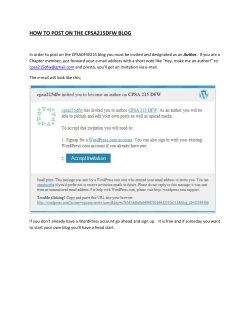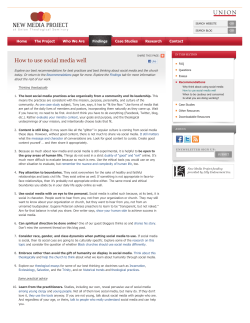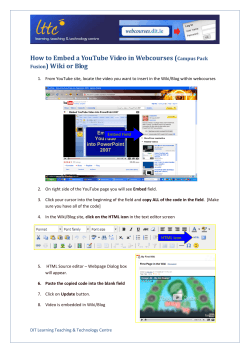
How To Blog Like A Pro Powered by
How To Blog Like A Pro Powered by Contents Introduction………………………………………………3 Blogging Platforms………..…………………………….4 Blogging Tools…………….…….………………………..6 Social Media…..…………………….…………………….8 How Often Should You Blog?.........................................10 Structure………………………………………………….11 Lessons Learned From Blogging..…………………...14 Introduction If you’re a small business owner, chances are you have a blog. But, even if you don’t, or are unsure of what they can do for you, then you’ve come to the right place. This guide is going to focus on immediately actionable tips and advice for your blog, what we’ve learnt through our blogging and how you can save time. Essentially, blog like a pro. Blogging Platforms There are a myriad of blogging platforms out there, some more technical than others. Generally, the most popular blogging platforms are Tumblr, Blogger and WordPress. There are different advantages to each, but generally Tumblr is great for image based blogs, Blogger is simple and friendly, and WordPress is the most robust. We use WordPress as it offers large amounts of customisation, has a very active support community and most importantly, supports plugins (extensions that offer extra features). We would recommend WordPress if you’re serious about your blog being a core part of your online strategy (you can build the rest of the site around it also), but the others are also great spaces. As a lot of small businesses tend to have static sites, this is quite a good idea. If you are using WordPress, there are a number of plugins we would always recommend: • Yoast SEO • WP Biographia • WP Super Cache These plugins can make a remarkable difference to your blog: • Yoast helps you sort out a lot of the issues Google doesn’t like. • Biographia puts a little “about me” section at the bottom of your posts and is an easy way to set up Google Authorship without having to do any coding. • Super Cache speeds up your site load time and makes for a better user experience. Blogging Tools There’s also a plethora of tools that can make blogging that much easier. These are our two favourites that save hours each week: Content Generator by SEO Gadget - a guide for which can be found on their blog. This handy spreadsheet allows you to input your keywords (say, “hairdressing” or “plumbing”) and finds the most popular articles online relating to those terms. From this, you can get an idea of what’s trending and who’s talking about it. It even suggests influential people who may be interested in your post. If you’re stuck for an idea, have a go and you might find a spark of inspiration. IFTTT (If This Then That) – it creates formulae, or recipes, for different online channels. That might sound a little meaningless, but it’s really very handy and easy. As an example, we have it set up so that whenever we post a picture on Facebook, that same picture and its description are tweeted as well. This saves us tons of time going between the different sites. You can also have it to update Twitter for anything that’s posted on Facebook, however we wouldn’t recommend this. Facebook and Twitter are used in very different ways and should be used accordingly. For blogging, it means you just have to publicise your post in one place and it updates it in many others! Instagram is another great platform for you to reach out to your user base, and enabling your customers to really visualise what you can offer them. Social Media Blogging and social media go hand in hand. Publishing your content through your social channels will help increase traffic massively and let your fans know that you’re offering them valuable information they might miss out on otherwise. To demonstrate how we tie our social media together, we’ll go through it step by step. Some of this will be specific to WordPress, but other bits will be applicable for everyone. 1. We have our blog post ready for publication and schedule it in depending on our publication calendar. 2. We preview the post and take a screenshot of the title and the first couple of paragraphs to upload onto Facebook. We do this because pictures are more heavily weighted in Facebook’s edge rank (the algorithm that determines how many people will see a post on their newsfeed). If you do embed a link instead, you should know that the information in the snippet is not set in stone. Things like the title and description are pulled from your post for the snippet on Facebook, but you can alter these easily. 3. The picture is then scheduled within Facebook to post about ten minutes after we’ve scheduled it to go up. A link to the post is provided in the description. 4. This photo is then tweeted up to 15 minutes after it appears on Facebook through IFTTT (it can take up to fifteen minutes for the formula to refresh itself, it’s not instant). We also schedule a further two tweets using Buffer about the post which appear in the evening and the following morning. Some people prefer to tweet more about each post, but I personally find that a little much – you will find lots of dissenting views on this though. How Often Should You Blog? This is going to sound a bit loose, but you really just blog as often as you are able. We tried to do every weekday but have found this a little difficult to manage. Instead, we’re going to do two times a week and really make sure we nail the content. However often you find yourself able (though we’d suggest once a week or so), do try to maintain a bit of consistency and coherency week on week. As an example, our new structures will be: ● Every Wednesday ● Every Friday ● A surprise blog here n’ there! We’ve found that for weekdays, publishing a post at around 12:30pm – 1:30pm is usually best as people are likely to be on their computers, browsing during lunch. We’re not quite sure about the weekends yet, but we’ll update you know once we have a bit more data on this. Our initial thoughts would be later in the day, when people have come back from a day out and before they head out for the evening. Structure While it might sound pretty boring, we’re afraid it’s essential. The most important elements in any post are: Content – This will be different for everyone. If you have competitors, check out their blogs, see what they’re doing with them and what they’re not covering so well. Just make sure it offers value to your readers. There’s plenty of advice on this online. Title – given that this is what draws your reader in, make sure it’s snappy and has a hook (like our title below). A good title describes your content in such a way that it becomes irresistible to the reader. Readability – there simply isn’t much point to blogging if it’s hard to read. Check both how easy to read the language used is, and what the post actually looks like. Notice that this one has small blocks of text broken up by subheadings and pictures. This makes the content much more approachable. Categories – not too many and try to put each post only in one or two. You can take a look at the ones here and by navigating to the Categories tab in the menu at the top. While your main focus should be on topics relating to your core industry, don’t be afraid to write on topics that deviate from this a little. Tags – don’t use them, just don’t. They make blogs messy and hard to navigate. We’re always turned off a blog that has a list of 50+ tags. Use your categories and internal link structures better instead. SEO (search engine optimisation) - a scary term for many to be sure. Don’t invest too much time into understanding all the different aspects that go into search engine rankings (for there are many and they are complicated), but it is helpful to understand the core concepts so that they can be incorporated into your usual methodology. In this post, for instance, when we link out to another site, or part of our own, we hyperlink numerous words together instead of saying “click here”. This sends signals to the search engines but is also more descriptive for readers. For more information, check out this great beginners guide to SEO by Moz and Google’s Webmaster YouTube channel. Calls to Action - end every post by asking readers to complete an action, whether it’s sign up, look at your services or leave a comment. Make the most of people being on your site by getting them to fulfill the action you want them to and increase your conversions. Half the point of having a blog for your salon is so that people will be drawn into reading and discovering more about your services. Sometimes you just need to ask explicitly. Settle upon a blog structure and a way of formatting for every post. Change it up if you find something that works better and update the old posts. Remember: Lessons Learned From Blogging It’s a process of constant refinement – we are continually thinking about ways we could better streamline the process and save ourselves even more time. We’re not suggesting we get all the elements we’ve mentioned correct for every post, but effort is put into them, and we believe this makes for a better user experience. There are many, many more elements that a great blog is comprised of, and if you do some research you’ll find a ton of advice. The purpose of this guideline is to give a few simple tips you can immediately apply to your process of blogging and suggest a few helpful resources where you can learn more detailed info. Good blogging can take a while; so don’t be put off if it does take a bit of time. While you might not see the effects immediately (or even for several months), if you blog well you’re setting yourself up to be more successful as finding services online becomes increasingly important. Lessons Learned From Blogging If you’ve found this guideline useful, or if you’d like any help or advice with your own blog, please let us know! And if you’re a small business that sells timeslot appointments, take bookings online totally FREE for 30 days at appointedd.com You can contact us via E-mail or Facebook as shown below: Email: hello@appointedd.com Facebook: www.facebook.com/appointedd Twitter: twitter.com/appointedd We look forward to hearing from you and have fun blogging like a pro!
© Copyright 2025
















